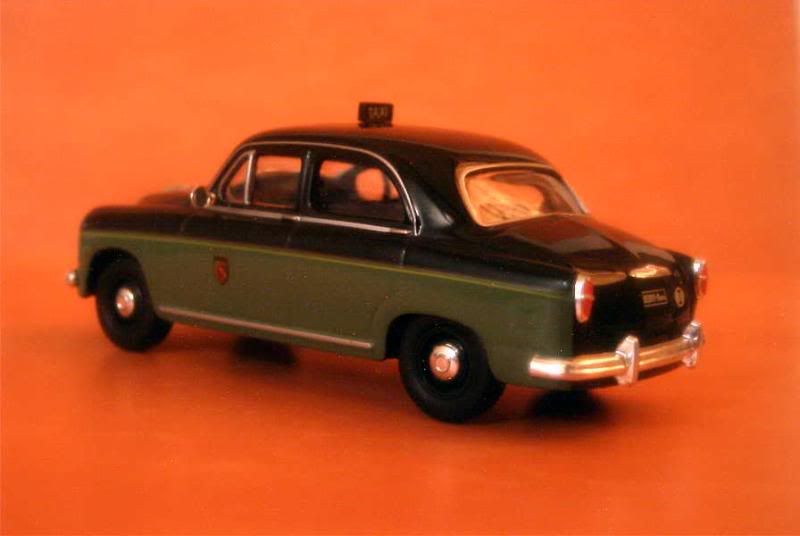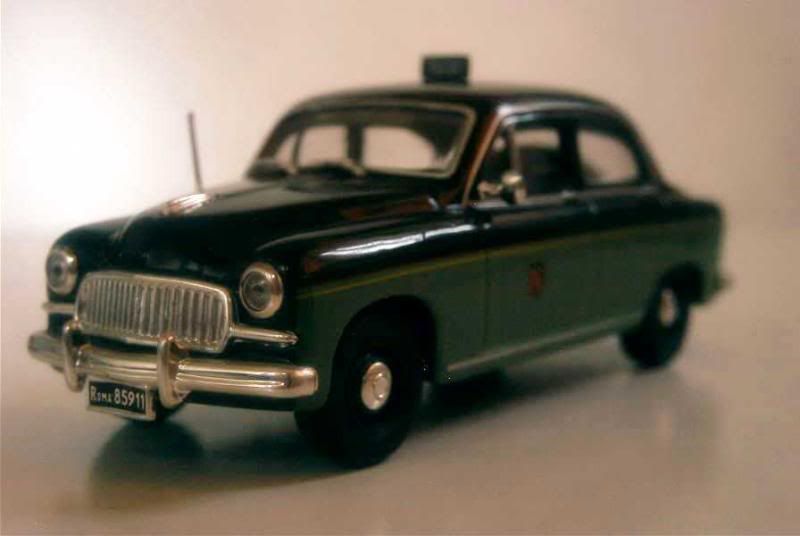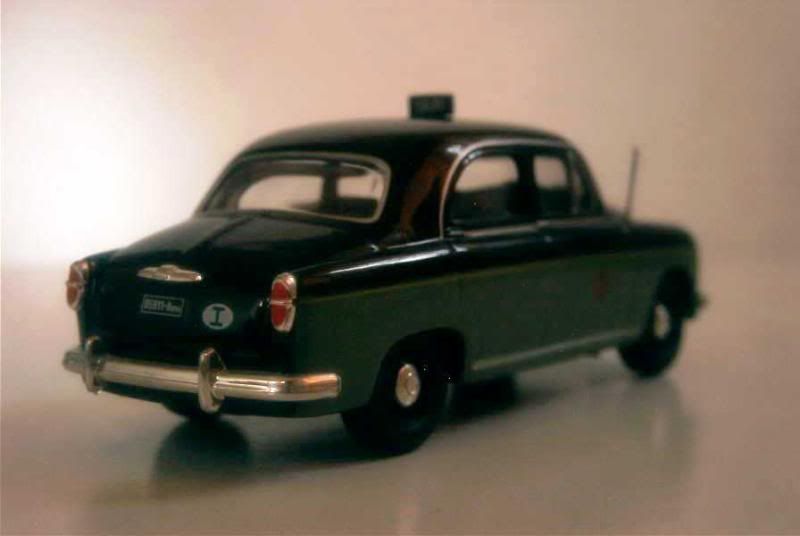A little history
Though its Kaiser-Frazer-inspired, bathtub-like styling seems rather heavy nowadays, in its time the Fiat 1400 was a modern car that gave its constructor the opportunity of many innovations.
Replacing the pre-war 1500 model, the 1400 was launched at Geneva in 1950. It was Fiat’s first monocoque car, though apart from its construction type the initial car was rather conventional. Its engine was a 1.4-litre four good for 44 bhp. A four-speed manual gearbox directed the power to the rear wheels. Suspension was independent up front, but a solid axle was fitted at the rear. Four drums took care of the braking. Top speed was only 120 kph but, hey, the Fiat 1400 was a family car and, furthermore, just owning an automobile in post-war, poverty-ridden Italy was already the sign of being privileged.
Initially available as a Berlina saloon or a rare convertible, the 1400 saw new versions appear at the Paris motor show in 1952 (the 1900 Berlina saloon and Gran Luce coupe) and Turin in 1953 (the 1400 Diesel). The 1900 was essentially the same car as the 1400, except obviously for its larger 1.9-litre, 60 bhp block and a 5-speed gearbox, a rarity at a time when even 4-speed transmissions weren’t common. The diesel engine, a 1.9-litre, 40 bhp four despite the name of the car, was also a Fiat first. Performances of this early diesel were obviously limited, but fuel economy was noticeable.
At Turin in 1954, the 1400 and 1900 became the 1400A and 1900A models. Most apparent was a facelift that brought to the cars a new front grille and slightly finned rear wings, giving the middle-range Fiats a family look with the Simca Aronde, which French by birth was still closely related to its Italian cousins though. Engines were modified, too. Power was now up to 50 bhp for the 1.4-litre, and 70 bhp for the 1.9.
Two years later, again at the inescapable Turin motor show, the “A” cars gave way to the new 1400B and 1900B. This time, bodies were only vaguely altered. Most modifications centred on the brakes and the transmission. A lone fog light mounted at the centre of the grille immediately identified the “B” cars. Engines were again improved, the boost now bringing their outputs to 58 and 80 bhp. Last but not least, two specifications that were then en vogue across the Atlantic were adopted: a two-tone paint available across the range and a pillarless “hardtop” body style for the Gran Luce coupe, the latter receiving a roofline not unlike that of the contemporary Ramblers.
The Fiat 1400B was produced until 1958, the 1900B surviving for a few more months before the six-cylinder 1800 and 2100 models succeeded them. About 100,000 had been built, less than one out of ten cars built being 1900s. To this total have to be added the many cars built abroad, under licence: this model was the very first car assembled by Seat (Spain) and the first road car produced by Zastava (Yugoslavia), while it was also built by Neckar (Western Germany) and Steyr (Austria).
About the model
Model: Fiat 1400A
Year: 1955
Maker: Ixo
Scale: 1/43
Distributed by: Altaya as no.12 of its Taxis du Monde press series
Acquired: second hand with neither stand nor box, in October 2007, through mail from a fellow collector from Rouziers de Touraine, France
Typical Ixo/Altaya model: nothing extraordinary, but not much to complain about, particularly when considering the price. My rating is 12/20.



Though its Kaiser-Frazer-inspired, bathtub-like styling seems rather heavy nowadays, in its time the Fiat 1400 was a modern car that gave its constructor the opportunity of many innovations.
Replacing the pre-war 1500 model, the 1400 was launched at Geneva in 1950. It was Fiat’s first monocoque car, though apart from its construction type the initial car was rather conventional. Its engine was a 1.4-litre four good for 44 bhp. A four-speed manual gearbox directed the power to the rear wheels. Suspension was independent up front, but a solid axle was fitted at the rear. Four drums took care of the braking. Top speed was only 120 kph but, hey, the Fiat 1400 was a family car and, furthermore, just owning an automobile in post-war, poverty-ridden Italy was already the sign of being privileged.
Initially available as a Berlina saloon or a rare convertible, the 1400 saw new versions appear at the Paris motor show in 1952 (the 1900 Berlina saloon and Gran Luce coupe) and Turin in 1953 (the 1400 Diesel). The 1900 was essentially the same car as the 1400, except obviously for its larger 1.9-litre, 60 bhp block and a 5-speed gearbox, a rarity at a time when even 4-speed transmissions weren’t common. The diesel engine, a 1.9-litre, 40 bhp four despite the name of the car, was also a Fiat first. Performances of this early diesel were obviously limited, but fuel economy was noticeable.
At Turin in 1954, the 1400 and 1900 became the 1400A and 1900A models. Most apparent was a facelift that brought to the cars a new front grille and slightly finned rear wings, giving the middle-range Fiats a family look with the Simca Aronde, which French by birth was still closely related to its Italian cousins though. Engines were modified, too. Power was now up to 50 bhp for the 1.4-litre, and 70 bhp for the 1.9.
Two years later, again at the inescapable Turin motor show, the “A” cars gave way to the new 1400B and 1900B. This time, bodies were only vaguely altered. Most modifications centred on the brakes and the transmission. A lone fog light mounted at the centre of the grille immediately identified the “B” cars. Engines were again improved, the boost now bringing their outputs to 58 and 80 bhp. Last but not least, two specifications that were then en vogue across the Atlantic were adopted: a two-tone paint available across the range and a pillarless “hardtop” body style for the Gran Luce coupe, the latter receiving a roofline not unlike that of the contemporary Ramblers.
The Fiat 1400B was produced until 1958, the 1900B surviving for a few more months before the six-cylinder 1800 and 2100 models succeeded them. About 100,000 had been built, less than one out of ten cars built being 1900s. To this total have to be added the many cars built abroad, under licence: this model was the very first car assembled by Seat (Spain) and the first road car produced by Zastava (Yugoslavia), while it was also built by Neckar (Western Germany) and Steyr (Austria).
About the model
Model: Fiat 1400A
Year: 1955
Maker: Ixo
Scale: 1/43
Distributed by: Altaya as no.12 of its Taxis du Monde press series
Acquired: second hand with neither stand nor box, in October 2007, through mail from a fellow collector from Rouziers de Touraine, France
Typical Ixo/Altaya model: nothing extraordinary, but not much to complain about, particularly when considering the price. My rating is 12/20.






2 comments:
Beautiful model.
It is not bad for a IXO.
JB
As you said, it's a rather good Ixo. The front grille's details perhaps appear a little too thick, but as for the rest, this is a nice model.
Post a Comment